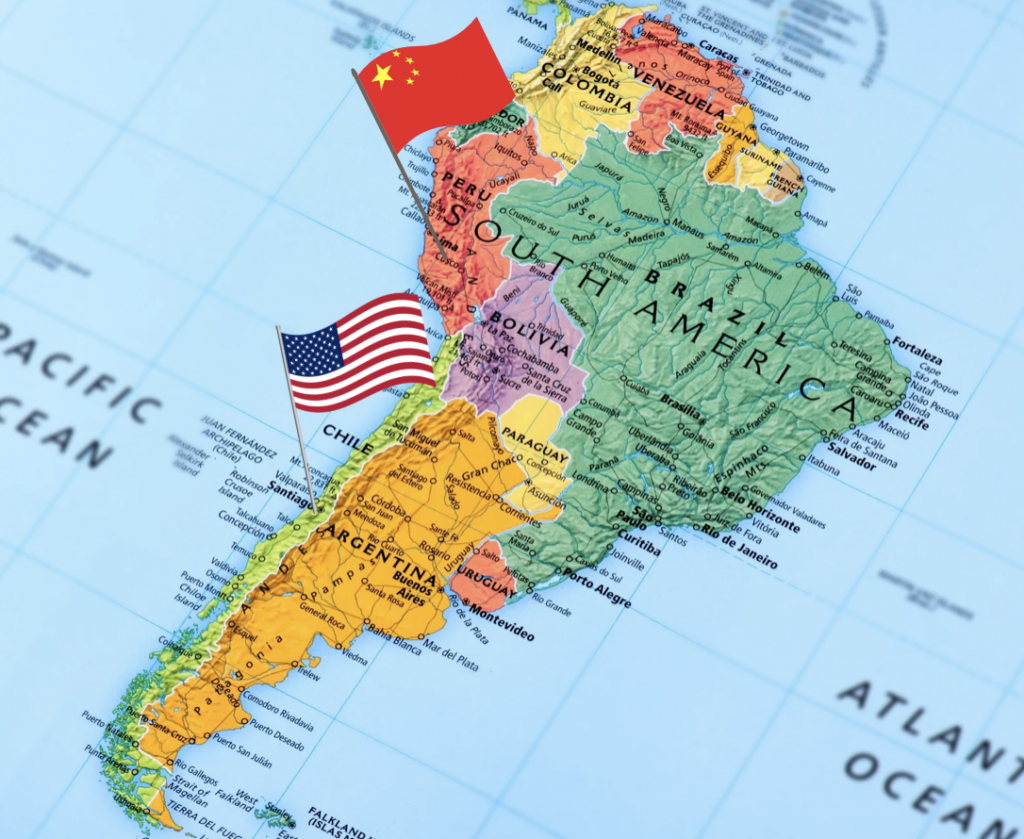By: Larissa Lozano

The United States remains a global superpower in economic and military power. However, it has been losing ground to China in the critical minerals sector for years. Critical minerals are rare earth elements (REEs) and substances essential for manufacturing technological equipment such as semiconductors, EV batteries, solar panels, and wind turbines. Sought-after critical minerals include lithium, nickel, cobalt, and copper. These mineral reserves are not in shortage, rather, mining and production abilities have not evolved at the pace of demand.
While Africa has historically stood as a key source of critical minerals, Latin America has gained leverage in the critical minerals market as importers seek to diversify critical mineral suppliers. The Lithium Triangle alone, which encompasses Chile, Bolivia, and Argentina, contains more than half of the world’s reserves of lithium, more than a third of its copper, and nearly one-fifth of nickel and rare-earth metals alongside smaller reserves of cobalt, titanium, zinc, and REEs.
Although Latin America’s reserves are abundant, its production capabilities are limited due to a lack of infrastructure and domestic investments in mining and supply chains. Protests over poor working conditions and environmental damages from mining expansions have taken place, which has built up opposition to foreign offshore investments.
Both China and the United States have demonstrated interest in Latin America’s resources, with China surpassing the U.S. as the region’s top trade partner as of 2025. With both countries searching for more sources of critical minerals, can their ambitions coexist in Latin America, or could the competition worsen tariff wars? With China already having an established presence in the region, can the United States successfully “catch up” or is it too late?
China is the world’s largest importer and exporter of critical minerals and dominates global refining processes. It accounts for 70% of global extraction and over 85% of processing capacity. In its expansion to the Western Hemisphere, China has heavily invested in Latin America to acquire critical minerals for its military, EV, and renewable energy industries. For decades, it has established free trade agreements (FTAs) with various Latin American countries, primarily Venezuela and Chile. Since 2017, it has invested billions of dollars in long-term major mining projects in Argentina and Peru through companies such as Tianqi Lithium and Zijin Mining Group. Additionally, China has been actively buying shares in local Latin American mining firms, such as Chile’s Sociedad Química y Minera (SQM), and has whole mines in Brazil and Peru. Consequently, Latin America’s geopolitical position has been limited to exporting raw materials and selling companies and mines to Chinese companies.
With China’s reach expanding over the region’s top mines and companies, there are growing fears of Latin American mines and companies being bought out and plagued by poor working conditions, as is the case in Africa. These fears are already materializing, as the Chinese-owned Peruvian copper mine Las Bambas was temporarily shut down in 2022 due to local protests.
The United States is among the top five world critical mineral importers, according to the World Trade Organization in 2022. Despite having considerable domestic reserves of magnesium and zinc, the United States relies on foreign imports for over 80% of its critical mineral needs, with China being its main exporter. Despite being key trade partners, U.S.-China trade relations have been tense over the years. This has culminated in China’s recent tariffs and bans on critical mineral and rare earth elements to the United States, to which the U.S. responded with tariffs on Chinese imports. Expanding into Latin America could help the United States decrease U.S. reliance on China for critical minerals while solidifying its influence in the Americas region.
The United States’ efforts and investments in Latin American critical minerals have been insufficient. The 2023 Inflation Reduction Act (IRA) is the most significant effort, which established a Free Trade Agreement (FTA) with Chile with tax subsidies to Americans who buy EVs made with Chilean lithium.
Instead of buying out mines and companies without regard for work conditions and local protests as China has done, the United States must take a relationship-focused rather than a colonial exploration-focused approach to Latin America. With its vast industrial capabilities, the U.S. could establish professional training, technology, and infrastructure exchange to build up struggling local supply chains, thus keeping profit and jobs locally. To complement its investment, the U.S. should negotiate Free Trade Agreements (FTAs) through the IRA similar to Chile’s with Brazil and Argentina, for example, focused on critical mineral security.
The United States cannot fully avoid or run away from China in Latin America. It must recover its regional leverage by fostering relationships rather than neo-colonial exploration to maintain critical mineral security before it is too late.

